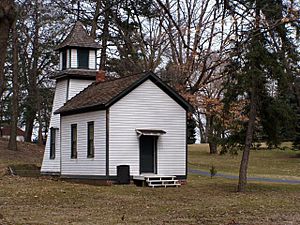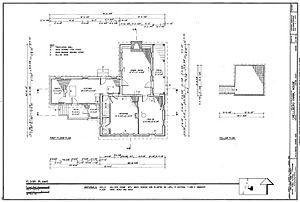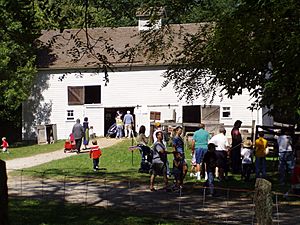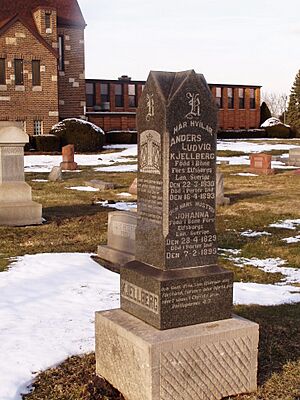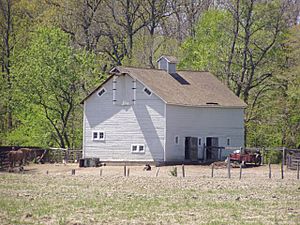Chellberg Farm facts for kids
Chellberg Farm is a special historic farm that became part of Indiana Dunes National Park in 1972. It's important because it shows the history of a Swedish-American community that once lived there. The farm has a family house, a water house with a windmill, a chicken coop (which was also a bunkhouse), and the original barn. Other nearby Swedish places, like the Burstrom Chapel and Cemetery, have also been saved and fixed up.
Contents
Swedish Community in Indiana
Swedish immigrants came to Baillytown, in Porter County, Indiana, for a few reasons. There were new jobs, and like many immigrants, they wanted to live near others from their home country. Baillytown was close to Chicago, which was a big hub for Swedish immigrants from the 1840s to the 1920s.
The railroad arrived in the 1850s, helping people settle and move lumber. A local story says that an early Swedish immigrant, Jonas Asp, helped Joel Wicker find Swedes, including the Kjellberg family, to work on his land. These new settlers then encouraged their friends and families to join them. The immigrants provided the workers needed to develop farms, railroads, and industries in the area.
The Swedish-American community was very close. They made sure to keep their culture alive by teaching their children Swedish, building Swedish churches, and holding social events where they celebrated Swedish traditions.
Farm Buildings and Their History
The Farmhouse: A Victorian Home
The main farmhouse was built in 1885. It's known as "folk Victorian" style, which was popular across the United States in the late 1800s. The house was first built in a "T-shape." It had a two-story section next to a one-story part. This design allowed for a porch to be added in the "L" shaped space.
The house had a living room, many bedrooms, and a kitchen. Later, a special fireplace was added in the dining room. A glass-enclosed front porch was also added, but it was removed when the house was restored.
Like many buildings in this area, local workers and materials were used. The red brick on the house is made from "porter brick," which came from the local clay soil.
The Barn: A Changing Structure
The barn is over 130 years old and is still standing strong. It was built between 1870 and 1879. In 1880, the Chellbergs had two milk cows, six other cattle, two sheep, and five horses. Over the years, the barn's use changed, and so did its design.
By the 1900s, the family was running a dairy farm. Windows were likely added around this time to bring in more light and fresh air. In 1917, a silo was built next to the barn to store silage, which is fermented feed for animals.
The barn is about 50.67 feet (15.44 m) long, 24.25 feet (7.39 m) wide, and 25 feet (7.6 m) tall. It was built using strong wooden beams from trees like oak, elm, ash, maple, and basswood. Carl Chellberg added a concrete floor in 1938. The barn faces east–west to get the most sunlight and is near a ravine that helps block winter winds.
The Corncrib: Storing Corn
The current corncrib was built in 1941 by Carl Chellberg. The Chellbergs had different types of corncribs over the years. This one is a single building used for storing corn. It's built on concrete posts to keep rodents away.
Large wooden beams are placed on top of these posts, and the floor is made from wood taken from the old silo. Later, a wire mesh was put inside the walls to protect the corn even more from pests.
The south wall of the corncrib was once shared with a tractor shed, which is now gone. That shed held the family's 1939 Allis-Chalmers tractor. Once they had the tractor, they used it instead of horses for harvesting crops.
The Granary: Storing Grains
This is a two-story wooden building located just west of the farmhouse. It was used for storing grains.
The Maple Sugar Camp: Sweet Treats
The sugar Shack, built in the 1930s, is a simple building made of concrete blocks. It was used to turn sugar maple sap into maple syrup. The building has one room, about 12 feet by 24 feet, with a concrete floor and a gable roof. Inside, there's a boiling pan over a brick fire box, connected to a brick chimney. This camp is still used every spring to make maple syrup.
The Chicken Coop: Home for Chickens
This small, one-story building was built around 1879. It has a gable roof with wood shingles and sits on a brick foundation. It's about 10 feet by 24 feet. The outside walls are made of vertical boards. The inside walls were plastered. This building was also used as a bunkhouse for hired workers.
The Chellberg Family Story
The Kjellberg Family Arrives in America
Anders Ludwig Kjellberg (born in 1830) and Johanna (Anderson) Kjellberg (born in 1829) got married in Sweden in the 1850s. They moved to the U.S. in 1863 with their son, Carl (born in 1859). Family stories say they moved straight to the Bailly area. They didn't live on the current farm right away. Their first home was on Mineral Springs Road.
The 1871 Great Chicago Fire destroyed much of the Swedish community in Chicago. Many Swedish people decided to move to the Swedish community in Indiana. A popular story says that the Kjellberg family met Joel Wicker (whose father-in-law was Joseph Bailly) in Chicago. Joel hired Anders to clear land for planting and gave the family a small log house to live in.
Anders Kjellberg had been a tailor and a preacher in the Lutheran Church in Sweden. He continued to be very religious after moving to America and helped start the Swedish Lutheran Church, which is now called Augsburg Lutheran Church. The Kjellbergs' second child, Carolyn, was born in the mid-1860s but sadly died young. They also had a foster son, Simon Larson, who joined the family before 1880.
Starting Life in Northwest Indiana
In October 1869, the family officially bought the Chellberg Farm property. On November 1, 1869, the Kjellberg (Chellberg) family took ownership of what is now Chellberg Farm. They bought 80 acres (32 ha) from J. H. Wicker for $12.00 per acre.
When they bought the land, there were no buildings, and it wasn't cleared for farming. In 1870, the family of four lived on the property with only 4 acres (1.6 ha) of land ready for farming. They hadn't grown any crops in their first year but had some animals, including two milk cows and two pigs. Their only farm product was 100 pounds of butter.
Clearing the land was a slow process. In a good year, they might clear only 15 acres (6.1 ha) of land. More likely, they cleared about 5 acres (2.0 ha) to 10 acres (4.0 ha) each year. Clearing the land also provided wood they could sell. Most farms in the area were small and grew a little bit of everything. The Chellbergs had an orchard that likely produced fruits like apples, pears, peaches, and berries.
On April 4, 1872, Anders Kjellberg bought another 40 acres (16 ha) of land. The first house (before the current brick one) and the barn were built between 1869 and 1872. It's believed that a well and outhouse were also built early on. By 1879, the farm had many animals, including thirty chickens, eight cows, two sheep, eleven pigs, and five horses. A chicken house was probably built before 1879, and a corncrib might have been built around that time too.
In 1879, the farm produced 100 bushels of corn from 9 acres (3.6 ha) of land. They also grew oats, rye, wheat, and Irish potatoes. They harvested five tons of hay from 5 acres (2.0 ha).
The brick farmhouse built in 1885 was a big change for the farm. While a new, larger house often showed wealth, the Chellberg farmhouse was built because the original family home had burned down. Using brick for the new house was likely a way to make sure another fire wouldn't threaten the family.
The Second Generation: Carl Chellberg Takes Over (1893–1908)
Anders Kjellberg passed away on April 16, 1893, at age 63. His son, C.L. Chellberg, became the farm owner. He bought out his mother's and sister's shares for $3500 and agreed to take care of them for the rest of their lives. C.L. took a more scientific approach to farming. He read "The Farm Journal" and subscribed to the United States Department of Agriculture Farmer's Bulletins starting in 1896.
C.L. Chellberg likely started to build up his dairy herd around 1901. His sister Emily and her husband Alfred Borg lived at the farm with their two children until 1901. Alfred was a carpenter, so he might have earned money working outside the farm. Johanna Kjellberg, C.L.'s mother, died in 1899. C.L. married Ottomina Peterson in 1901, and then Emily and Alfred moved to their own home nearby.
The Chellberg Dairy Farm (1908–1937)
By 1908, the Chellbergs had changed from growing mostly grains to focusing on dairy farming and some grain. The Chicago, South Bend and South Shore Railroad had been built, and a train stop was only a mile away. This meant they could sell milk to a dairy in East Chicago every day.
Over the next years, C.L. and Ottomina's children, Naomi and Carl, and their children continued to work on the farm. Naomi moved away after she married Alden Studebaker in 1926. Even the grandchildren, Ann Chellberg Medley and Henry and Arthur Studebaker, spent much of their childhood on the farm. The dairy operation likely stopped sometime between the 1920s and 1930s. This might have happened when the South Shore train stop near the farm closed, or it became too hard to get the milk to the train every day.
The Third Generation: Carl Chellberg Jr. (1937–1972)
C.L. Chellberg died in 1937. The farm was then shared among his wife and three children. His son, Carl Chellberg, took on the main job of managing the farm, but everyone helped make decisions. They found it hard to keep up with the changing economy as factories and businesses replaced farming as the main way to earn money. Like many farmers today, Carl worked in town to make enough money. He found a job in a machine shop in Chesterton.
In 1938, Carl married Hilda Johnson. They had two children. They lived in an apartment on the remodeled second floor of the farmhouse. Minnie Chellberg, Carl's mother, passed away in 1952 at age 82. Minnie had managed the vegetable garden and the flowers in the front yard. She also took care of the orchard and continued to raise chickens.
Sometime in the 1940s, Carl Chellberg started raising sheep, keeping about 60 sheep. The sheep were sold at auctions for meat. The sheep grazed all over the farm property and were kept in two sheep sheds built during this time. A large addition was built onto the south side of the barn in 1954 by Carl Chellberg, Henry Studebaker, and Arthur Studebaker. Another smaller sheep shed was built behind the granary. Eventually, in the mid to late 1950s, Carl Chellberg took a job at a machine shop in Chesterton and sold the sheep. Hilda Johnson Chellberg worked as a cook at a local restaurant. Once both Carl and Hilda had jobs off the farm, the farm became a secondary effort and was no longer the main family business.
Around 1940, electricity was brought to the farm. During 1943, 1944, and 1945, Henry and Arthur Studebaker grew vegetables on the farm to sell to local people. They had a 2-acre (0.81 ha) garden where they grew many different vegetables like asparagus, beans, carrots, tomatoes, and corn. They sold these vegetables door-to-door in Dune Acres.
Nearby Swedish Landmarks
Other nearby Swedish landmarks have been restored or preserved. These include the Burstrom Chapel and the Burstrom Cemetery.
See also
- Indiana Dunes National Park
- Swedish American
- Swedish emigration to the United States
- Swedish Farmsteads of Porter County, Indiana
Images for kids



